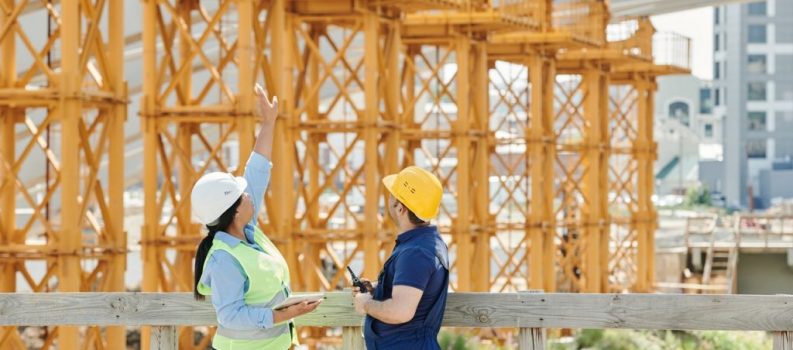Construction projects involve many moving parts at all times, which is why it makes sense that there are unique risks to each process and aspect. Being more aware of these risks, though, can help prevent these risks from hindering the progress of the construction process. That’s why we’ll be covering these risks in this article.
-
Poor project management
One thing you want your construction project to have would be excellent project management in place.
Your overall efficiency is much better when you have great project managers in place. You have someone overseeing the entire process, so that someone is responsible for ensuring the project is going smoothly and in the right direction.
Poor project management can increase the chances of delays, cost overruns, and other risks that can compromise the project outcome. Poor project management can also lead to subpar quality and safety issues that can put workers at risk.
Construction companies must ensure that they have robust processes for managing their projects effectively. A great project manager can help make this a lot easier. By taking these steps, companies can minimize the risks associated with poor project management and maximize their chances of delivering successful projects.
2. Supply chain issues
Construction projects deal with many items and supplies moving throughout the construction project’s physical area and throughout the entire process. Since this part is a constant, it makes sense that you will often encounter supply chain issues.
Poorly managing your supply chain can cause delays, cost overruns, and other problems that can compromise the project’s success.
Supply chain issues can arise from various sources, such as inadequate planning, lack of resources, poor communication between stakeholders, or unreliable suppliers. These issues can also be from external factors like regulation changes or unexpected weather conditions.
The key to managing supply chain risks is identifying potential problems early on and taking steps to mitigate them. Having a comprehensive understanding of the supply chain process and developing strategies to reduce delays are just a few ways to deal with these issues well.
3. Delays in material delivery
A part of the supply chain issues you often encounter is delays in material delivery. If you have an incredibly complicated or specific kind of material that you’re looking to use for your construction project, the materials would usually take a long time to get to you, especially with limited supplies. Utilizing specialized equipment like Felling trailers can help mitigate these delays by ensuring efficient and reliable transportation of materials.
Delays in material delivery can significantly affect the progress of the project, as well as its cost and quality.
Material delivery delays can cause problems for construction projects, from budget overruns to missed deadlines. In addition, delays can lead to a decreased quality of the finished product due to rushed work or incorrect materials that you used in the project.
Delays can also disrupt the workflow, resulting in further delays and additional costs.
A proper site logistics plan should help you manage the movement of your construction materials through the entire construction process.
4. Unclear scope of work
It is best for all the parties involved in a construction project to be as transparent as possible with the work they need to do. Clients should be clear with contractors and vice versa. Otherwise, when the scope of work is unclear or unclear, it can lead to unexpected problems and risks that could compromise the project’s success.
The lack of clarity in the scope of work can cause delays, cost overruns, and even disputes between contractors and clients. All parties involved in a construction project need to clearly understand the scope of work so that everyone is on the same page regarding expectations.
Without this clarity, there are no guarantees that all stakeholders will be satisfied with the result. On the other hand, contractors can spend much longer on a project than they’d like.
5. Health and safety hazards
Construction projects are quite a physical undertaking in every sense of the word. That’s why it shouldn’t be surprising that you will encounter health and safety hazards during the process.
Although it’s something familiar, that doesn’t mean you should ignore it. Health and safety hazards, in particular, can have severe consequences for construction projects, as they can compromise the overall quality of the project or even lead to costly delays.
To ensure that your construction project is successful, it is essential to be aware of potential health and safety hazards and take steps to mitigate them. Proper safety precautions and having all the protective equipment ready will help.
6. Inaccurate project estimation
When budgeting for a construction project, ensure some financial padding in case the project costs much more than first thought. Ideally, the first project estimation is as close to the possible expenses, but to avoid unwanted surprises, ensuring you have a larger budget than the project’s estimation can help prevent delays.
There are tools out there that can help with better and more accurate project estimation. A professional contractor can also help with more precise analysis.
7. Lack of skilled labor
Your contractors will be the blood flowing throughout the entire construction process that is making it work. Therefore, the last thing you would want to skimp on would be the skilled labor in your construction process.
They might need to be qualified to take on your work. They might also damage your construction project, which can lead to more expenses for you in the future. Therefore, research until you find a contractor within your budget and skilled enough.
8. Lack of environmental analysis
Studying the environment around the construction site will be critical to the success of the construction.
If you skip this step, the construction process might inadvertently cause damage to the nearby environment. You wouldn’t want these physical and legal repercussions to be in your way, so check out the surroundings and do your due diligence when undertaking a construction project.
Conclusion
Now that you are more aware of the risks, it will be easier to think about these things in the back of your mind. It will then help you be more aware of the factors that can make these risks easier to occur in your projects so you can avoid them.









